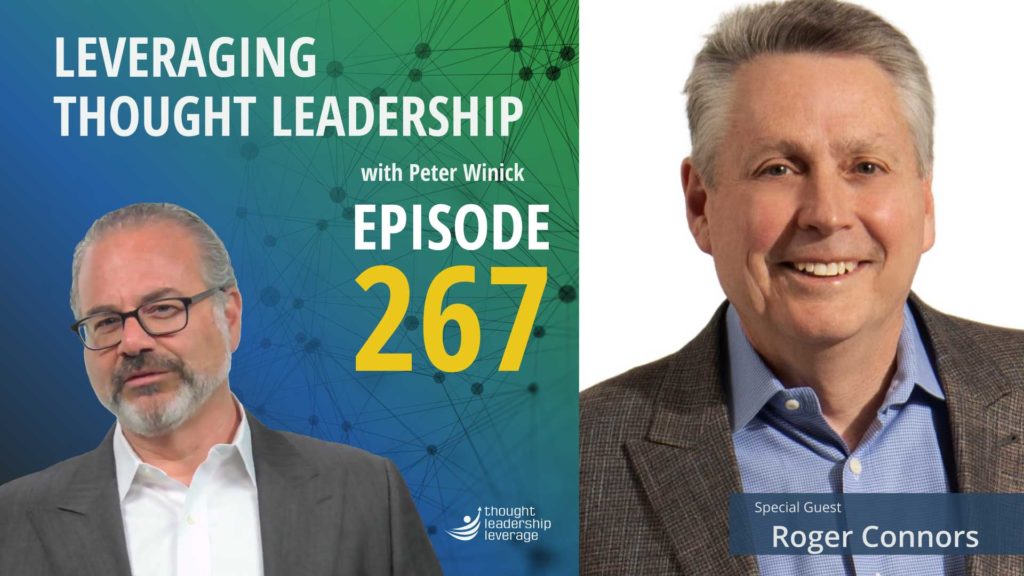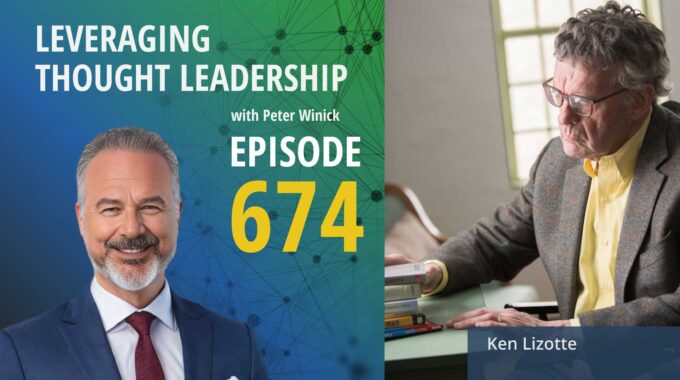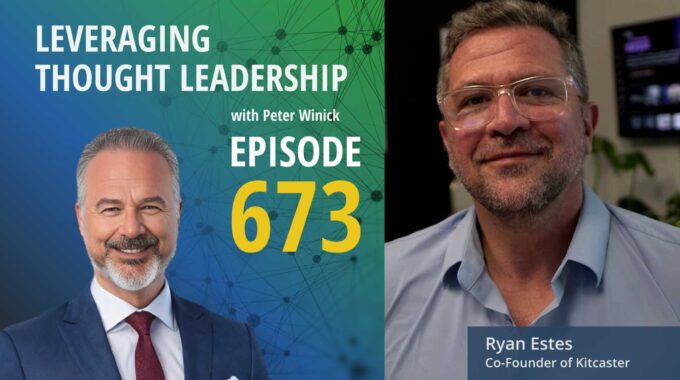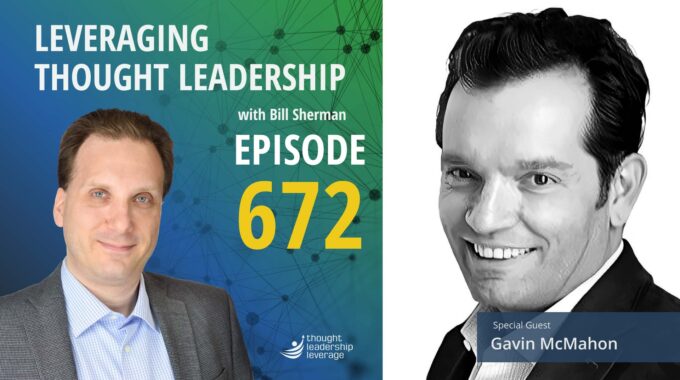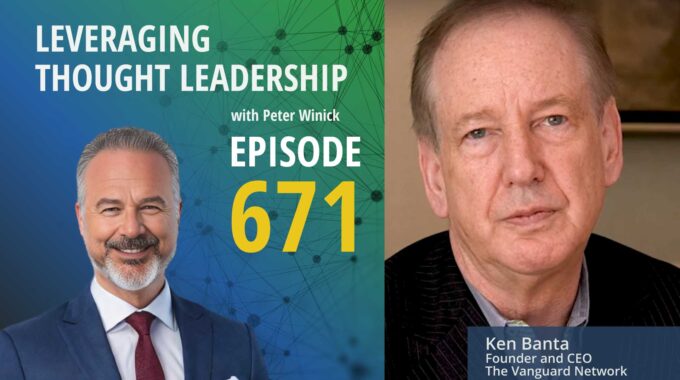Why Great Thought Leaders Don’t Play the Publisher’s Game Peter talks with publishing expert Ken…
Coaching with Thought Leadership | Roger Connors
Using thought leadership to create an organization full of coaches
An interview with Roger Connors about writing his first book, having a successful exit from his business, and the strategy that everyone can be a coach.
Today’s guest is Roger Connors, chairman and co-founder of Zero to Ten. He is the best-selling author of Fix It, Change the Culture, Change the Game, and his upcoming book Get a Coach, Be a Coach. Roger co-founded of Partners in Leadership before having a successful exit. He is also one of the top organizational cultural professionals in the world.
Roger shares with us how his first book turned into a tipping point for his business to be a break out success. We discuss the lessons learned while building Partners in Leadership and the steps it took for him to successfully exit the company.
In addition, Roger talks about his new book Get a Coach, Be a Coach. He explains how the average person has ten coach ready skills. Finally, we talk about how to get the best out of those skills and coaches as well as the technology needed.
If your organization is seeking coaches, you might be surrounded by them and not even know it! This is a great episode for anyone looking for or looking to become a coach for their organization.
Three Key Takeaways from the Interview:
- If a thought leader wants to be able to exit their business, then it needs to be based around models and not your name and charisma.
- The average person has ten coach ready skills and most skills take fifteen minutes or less!
- Thought Leaders using digital solutions need to help organizations adopt a culture that can use it, not just teach them the ins and outs of the software.
Do you want to grow more opportunities as a thought leader? Contact Thought Leadership Leverage for assistance. We can help devise a strategy along with many other aspects such as research, sales, and marketing.
Transcript
Peter Winick Welcome, welcome, welcome. This is Peter Winick. I’m the founder and CEO of Thought Leadership Leverage. And you’re joining us on our podcast, which is Leveraging Thought Leadership. Today, our guest is Roger Connors. He’s the chairman and co-founder of 0 to 10. Let me give you a little bit of Roger’s background because he’s got an interesting background. He’s a four times New York Times and Wall Street Journal bestselling author. He’s ranked by the top 30 global gurus as one of the world’s top ten world cultural professionals. He’s developed the number one award winning content and has published and interviewed extensively, including coauthoring, the bestselling books The Odds Principle Change the Culture, Change the Game and his most recent book, Get a Coach, Be a Coach. Currently, he’s the chairman of 0 to 10, which is a coaching and leadership company. He was also the co-founder and former CEO of Partners in Leadership, which is a training development company which trained millions of people in over 50 countries. So welcome aboard, Roger. You’ve certainly got a little bit of experience in this sort of crazy game of leadership. So let’s start. So if I were to say to you, I don’t know, 30, 35 years ago, what are your plans? And then say to you now, how did that work out? What might that look like?
Roger Connors You know, it’s interesting question. I think I would say we’re really glad it worked out the way that it did. But we didn’t want to make your plans and then watch that not happen. Right. So interesting. I think probably the most important thing we did was write her first book. You know, when we started, we had we had all the our clients were all the medical device companies of Eli Lilly. And we were getting good referrals. And but trying to break out of the medical device industry was really tough. We did a lot of things.
Peter Winick You were trying to partners in leadership? Yeah, yeah, yeah.
Roger Connors And then so writing the book was like just an important tipping point for us to kind of cause the business to break out the way that it did. And it all went from there. So yeah, good, good to have happen that way, but didn’t, didn’t plan it all this way.
Peter Winick Yeah. So you’re one of the very few in this business that has done the things that thought leaders do, write the books, create great content, be recognized for it and such, but also which is not the part that’s just as notable or as public, if you will, you know, Built a great Business was a phenomenal brand. Had a successful exit. I mean, that’s the holy grail that most people dream of and then transitioned into sort of new content and new stuff. So how did you sort of walk us through the journey a little bit? Because I think a lot of people I had a mentor years ago that said to me, any Dumbo can get into business. It takes a smart guy to get out. And you do think about that when you go into a company about you sort of what are the lessons that you learned when you built up partners in leadership and why you were able to have a successful exit?
Roger Connors I think initially it started with how we named our company, you know, its partners in leadership. It wasn’t named after us.
Peter Winick That’s a good point.
Roger Connors Time was, you know, it was more about personalities. And so we started with the eye in mind that, look, someday we’re going to want to transition this. So we need to build the equity around something different than just the two principals. So that’s where we started. And I think the part of part of that’s just running a good business, you know, when you’re when you’re in that moment of trying to find an exit, you know, what they’re looking at is not just reputation and intellectual property and presence of the marketplace. It’s Ibadan profitability. Right? So did you run it? Did you run a successful business? And I think as I look back, there wasn’t a year in our 28 years we didn’t have a profitable year because of the way we ran the business. So we I think we were very attentive to making sure that the business worked at the business model.
Peter Winick So I want to push on to things you said there. I love that. You know, it wasn’t called the Roger Connors company because that’s the typical model, or Roger’s Inco or whatever, right? So it was really named about a platform that’s not married to you, right? So you’ve gone on and that company still thrives, etc.. Talk about the transition, because even most content based businesses aren’t really businesses right now. And what I mean by that, they’re really practices, right? You have the rock star and the named author. They do a bunch of things. They get paid to do those things and sometimes they have other people doing things. But one of the things that was done properly, my opinion IT partners is it’s a it wasn’t focused on a personality, but you had frameworks and models and methodology and turned it into a business where it wasn’t dependent on you. So how did you go from knowing this content works? It sticks and provides value to saying, okay, let’s grow this, let’s grow this in a proper way. What did that what would that look like?
Roger Connors Well, part of that, too, was, you know, putting the intellectual property packages together. Right? So it’s building the IP platform in a way that wasn’t dependent upon us that that others could come into the organization, pick it up and use it with clients and have it work and what clients? Remember. They remember our name so much as they remember our models. And I’ll see people today and they’re like, the results determined model are the accountability. That’s accountability. And like, man, that was life changing. That’s what they remember. So we saw that early on and began just thinking, okay, how do we create the right model? That simple, easy to remember, highly impactful. And that was our focus. It was never about us. It was always about that.
Peter Winick Well, and the fact that it was. Models based and not charisma based because you can you know, there’s plenty of people out there that make a pretty good living because of their energy, their charisma, their, you know, their crazy life story. But it’s really nothing is my opinion. Teachable until it is based on a model that you can replicate and take across zillions of different people in zillions of different locations, fields, industries, functions and say, no, this is the results pyramid. This isn’t here’s the pyramid and you’ve got to do this and where are you? And I think the language of a model is important to people can communicate. You know, this is what they’re talking about. You know, when you’re talking about a blue sky and I’m talking about a blue sky, we have a model that says, though, blue skies are about this shade of blue, not ocean blue, sea blue, whatever. So. Well.
Roger Connors It was tempting. Ego egos, a tempting thing, right? So, yeah, I was when, you know, we had the opportunity to try to make it about us. And I remember we started pricing ourselves in terms of keynotes. We kept increasing our price. Yeah. To find that point where people would not want us to come and they would they would want one of our guys to come and that, that we ultimately became successful in that. But I think the, you know, I think when we ended, I think when I transitioned from the company, we had something like 300 trademarks worldwide. So we really paid attention to developing that that IP in a way that had value.
Peter Winick Yeah, that’s fantastic. Great. And you had clients that loved it, so then then you have an exit. So that’s a rare thing in this space. And I guess you were a failure at retirement.
Roger Connors Well, I exited. I didn’t retire and there’s a difference. And of course I signed a non-compete so that that made that. So that’s how my house got done. So, yeah, we finished that project and luckily I was able to get a carve out of my non-compete that allowed me to lean back in because this coaching platform they’re working on now, it’s just been super exciting and fun and that’s just in my genes, you know, that’s. Thought leadership, the opportunity to kind of develop scalable models that really make impact on organizations, improve quality of life of employees, customers, everyone, stakeholders. That’s what I’m all about. So I was really glad I could keep doing that.
Peter Winick Tell us about. The book, I mean, because this is a relatively new business, but you’ve got great plans. You’ve got the book. You know, you’ve got your models. Tell us the story now.
Roger Connors Well, it’s interesting because when I several years ago, one of the observations I had about transforming organizations is, is the impact coaching can have on people when it’s done well. And I experienced that many times as myself, being a coach to senior executives and organizations that I worked with, but also watching that process. And then and then I started thinking about it and I thought, you know, why? Why does an everyone have a coach? Like, why isn’t coaching a mechanism that’s working like throughout the entire organization, regardless of organizational level? And of course, the first instinct is, well, it cost too much, right? You can’t go higher. Well, then it was like, well, wait a minute. The best coaching I ever facilitated was coaching between peers, where if I was coaching a CEO, it would be, well, go get feedback from so-and-so and, you know, find out their perspective. And that was usually within the organization.
Peter Winick If you’re enjoying this episode of Leveraging Thought Leadership, please make sure to subscribe. If you’d like to help spread the word about our podcasts, please leave us a review and share it with your friends. We’re available on Apple Podcasts and on all major listening apps as well as at ThoughtLeadershipLeverage.com/podcasts.
Peter Winick So I wanted to stay there for a moment if we could. So one of the things that I think you’re 1,000% correct is this whole peer-to-peer model. So the old model, when you and I went to school was whoever’s at the front of the classroom or the workshop or whatever, they’re smarter than me. So I just better sit there and take it all in. I’m going to be responsible, write down a bunch of notes and just. Yes, yes, yes. Wow. Thank you. Thank you. The reality is, as we start to understand adult learning theory, more particularly in the business environment, yes, you may be the expert in whatever your thing is agility, resilience, creativity, innovation, whatever. However, I’m going to spend a lot of time with my peers in this room, and they see me every day. The way I really show up in a meeting, tackling a problem, working with a client. And if we can give them, scale them up to a baseline, that peer to peer piece is the most powerful behavior change. It’s the basis of all the 12 step programs. It’s the basis of everything. And it took us a really long time until learning people to realize, wait a minute, it’s not about us. It’s like, let’s unleash the power that these smart people have. And by the way, we’re jumping on a plane and going back to Denver tomorrow. So what can how do we do that? So it seems like that’s sort of the basis. The underlying thinking. Is that is that right?
Roger Connors Yeah. You know, kind of flipping the accountability model, letting people be self-directed like you’re describing, and at the same time tapping the expertise around them. We are. Our research has shown that the average person has about ten coach ready skills that they can actually coach on. They have many more skills than that, but the coach rating is kind of qualified, able and willing. So you’re surrounded by people who can help you get what you need. You know, bite size, real time on demand, skill based, right. So it’s not mentoring that mentoring is kind of longer term work.
Peter Winick Yeah, yeah, yeah.
Roger Connors It’s not executive coaching where there’s a subject matter expert coming in on to go deep. It’s really just kind of getting me what I need right now to take the next step in my journey to get results. And you’re surrounded by people all the time that can do that for you.
Peter Winick So unlock rates, I would imagine part of that is to get everyone in the organization to realize, okay, there’s the ten skills that Peter has and here’s the ten skills that Roger has. And we don’t have to have a long term coaching relationship. I could just identify Roger has a skill that I need. Can I pick up the phone and call Roger on the third floor and say, Hey, hey buddy, I need some help. And with this specific thing that I know you have expertise in.
Roger Connors That’s right. So in my past company, Partners in Leadership, we developed a digital platform for collaboration. We had about a minute on it. And now in this new business, we’ve created a software platform that helps to make those matches, coaching matches. But that’s one of the things in terms of this business that I’ve learned is, look, if you’re not looking for digital solutions, you’re toast. You’ve got to be able to scale it digitally within an organization, and that has to be a part of your content package. And we found a nice match for that because now when people get the insight, they go, my goodness, what am your CEOs are saying? And what you’re telling me is I have a thousand people in my organization. They each have 10,000 code trading skills. I mean, they have 10,000 coaches. My goodness. How do I unlock that? Like, how do I get people connected? And of course, a digital solution really is the only efficient way to making those matches and getting that done.
Peter Winick So you have a cost factor, right? Digital is the only way to unleash that. The other piece is one of the downsides of bringing in an external coach is sort of the culture fit. Do they really know how things go on here? You know, there’s all of that. So we’re both at Company X, We sort of know the know that’s not going to fly here because you might make a very well-intended recommendation as a coach. The outsider, but have no idea that that just won’t work here. That’s not the way it’s done, if whatever, you know.
Roger Connors One of our studies showed that 68% of the cooking is done in 15 minutes or less, that people actually get to the end organizations.
Peter Winick So it’s cheaper. It’s faster. Yes. Right. And yeah, and I’m thinking it’s better too. So that’s interesting. You’re really turning coaching on its head. I want to go half a step back to the digital piece that you said, because again, I couldn’t agree more. This is this is getting boring to just constantly agree with. You want to find something to disagree.
Roger Connors About.
Peter Winick At some point. But Covid has forced this on people and some people are doing it well and some are like, digital means I go on Zoom. No, I think I want to talk about when you talk about digital solutions, it has to be designed as a digital solution, not a, you know, recording of, you know, not something whose DNA is really analog or just what came out of a workshop. Talk about designing from digital from the bottom up like this will only live in a digital world. What it needs to do, what pitfalls? Things you need to look out for. Talk about that.
Roger Connors Yeah, you bet. I my view on it, it has to be done with the in the context of kind of having a cultural impact. So you just can’t throw software at an organization. Expect it to work. Not this kind of software. It just won’t. Right. So it has to be accompanied by a change in thinking. So the training side of it is really important. Like marrying these two together is essential. Yep. So there’s some content that goes along with helping people think differently about when do I reach out for coach? We have five coaching triggers, you know, is it okay to ask for help at our organization? Because right now if you raise your hand has for I ask for help, you look like you’re not doing your job. So there’s some cultural shifts that kind of have to go along with this. That’s accomplished through the training side. So we in that we impact the way people think. And then we’re now at everyone’s spot in and going, okay, what do I do? Then this digital piece comes in and that digital piece has been designed to plug into the content so they’re not separable. You need the training concepts to go with the digital interaction to be the complete package to really work.
Peter Winick Okay. So I want to play that back to you. So if it was just, hey, I got an email today that we install this new software, whatever, this new library, this new suite of tools. Hey, Peter, here’s your log in and credentials go at it. You’re not so good, right? Yeah. Good luck with that. We know what that looks like. You get a you look six months later and there’s a, you know, usability rate of like 7% or something like that, and they’ve used it once to whatever. So you have to set the table of a coaching is not only acceptable, it’s encouraged here. Here’s why. You know, so there’s a cultural piece here. How does that get pushed out? Is that digital? Is that training? Or because if you don’t lay that foundation, it sounds like software is just going to sit on a server somewhere in the cloud anyway?
Roger Connors Yeah. I always tell them it’s not a coaching solution, it’s a culture solution. It’s going to you got to do. And so, you know, there’s got to be a kind of a management buy in and they we encourage them do coaching call outs, their senior leadership meetings or the leadership meetings. They’re telling stories about coaching what’s working because leadership has to send the message this is important to us. Like we see this as essential to our growth and progress as an organization. So we’re going to reinforce it. So like any culture change, yeah, you’ve got to have that essential leadership buy in to make it happen.
Peter Winick Are you starting then by working with the senior leadership team for whatever, three months, six months, whatever, to get them sort of inculcated?
Roger Connors Just usually what’s happening is the leadership team is going through this process together and then there’s continued reinforcement with the leadership team on their role in reinforcing this culture change to a coaching culture. Well, there’s so many organizations out there that are working on coaching and they’re frustrated. There’s a whole bunch of folks that are using mentoring to try to solve a coaching problem because mentoring was their tool of choice. That’s what they understood and were familiar with. So part of this is kind of redefining the problem in a way. They understand it and then once they do, it’s getting really clear about, okay, how do we attack that and isolating that as a variable, Meaning what our people need is coaching right now, that bite size, real time on demand kind of interaction. And once an organization gets that insight, this is a pretty easy thing to understand and focus on.
Peter Winick Got it. So as we start to wrap up, if there’s someone out there now who’s got some great content, maybe they’ve read the book or they’re acknowledged in their field or they’re doing some speaking or whatever, but let’s call them, you know, Roger, 20 years ago, 25 years ago or whatever, and they want to have a level of success either measured by the impact, the amount of people they’re touching, as well as revenue generating and any words of wisdom that you’d have for them. But we’re all leaning in now.
Roger Connors Roger Yeah, yeah, that’s going to be tough. So to two things, just instinctually. Number one, what you’re doing is already too complicated. Just. Just love it. Just understand that it’s way too complicated. Whatever it is, I haven’t seen it yet, but I already know it’s too complicated. So step one is to simplify and reduce so that people can remember it and scale it. So that’s number one. And number two is make sure that you’re constantly tuning it to solve the problem. It was designed to solve because right now it probably doesn’t do it quite the way you need it to. So you have to continually to be inventive about getting it right. And if you have a passion for getting it right and keeping it simple, you’ll win.
Peter Winick Very well said, because I think there is a tendency for smart people to constantly, in the spirit of making it better and having a new way to do it and thinking about it further and further, it sort of becomes like the attic. And there’s a lot of stuff in there, right? The attic is usually not the most organized room in the home, so I agree. It’s simple. I love it. So and this has been great. I appreciate your time. I appreciate all that you shared. And I think there’s lots that we can learn from your journey. And I wish you continued success with this newer space now.
Roger Connors Thanks so much, Peter. I appreciate it.
Peter Winick Great. Thank you so much.
Peter Winick To learn more about Thought Leadership Leverage, please visit our website at ThoughtLeadershipLeverage.com. To reach me directly. Feel free to email me at Peter at Thought Leadership Leverage dot com. And please subscribe to Leveraging Thought Leadership on iTunes or your favorite podcast app to get your weekly episode automatically.
